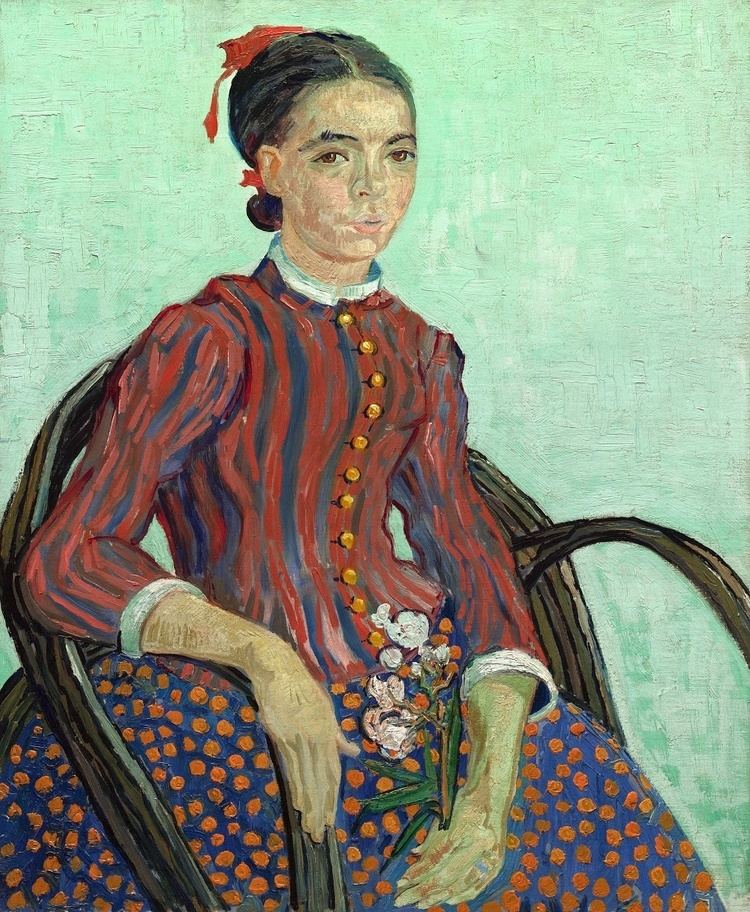Year 1888 Medium Oil on canvas Media Oil paint, Canvas | Catalogue F431 Created 1888 Support Canvas | |
 | ||
Dimensions 73.3 cm × 60.3 cm (28.9 in × 23.7 in) Similar Vincent van Gogh artwork, Artwork at National Gallery of Art, Canvas | ||
Pathe diffusor la mousme ganne
La Mousmé also known as La Mousmé, Sitting in a Cane Chair, Half-Figure (with a branch of oleander) was painted by Vincent van Gogh in 1888 while living in Arles, which van Gogh dubbed "the Japan of the south". Retreating from the city, he hoped that his time in Arles would evoke in his work the simple, yet dramatic expression of Japanese art.
Contents
- Pathe diffusor la mousme ganne
- Height of Van Goghs career
- The painting
- Provenance
- La Mousm drawing
- References
Height of Van Gogh's career
At the time that van Gogh painted this portrait he was 35 years old. Living in Arles in southern France, he was at the height of his career, producing some of his best work. His paintings represented different aspects of ordinary life, such as Harvest at La Crau and this painting, La Mousmé. The sunflower paintings, some of the most recognizable of van Gogh's paintings, were created in this time. He worked continuously to keep up with his ideas for paintings. This is likely one of van Gogh's happier periods of life. He is confident, clear-minded and seemingly content.
In a letter to his brother, Theo, he wrote, "Painting as it is now, promises to become more subtle - more like music and less like sculpture - and above all, it promises color." As a means of explanation, van Gogh explains that being like music means being comforting.
A prolific time, in less than 444 days van Gogh made about 100 drawings and produced more than 200 paintings. Yet, he still found time and energy to write more than 200 letters. While he painted quickly, mindful of the pace farmers would need to work in the hot sun, he spent time thinking about his paintings long before he put brush to canvas.
The painting
Inspired by Pierre Loti's novel Madame Chrysanthème and Japanese artwork, van Gogh painted La Mousmé, a well-dressed Japanese girl. He wrote in a letter to his brother: "It took me a whole week...but I had to reserve my mental energy to do the mousmé well. A mousmé is a Japanese girl—Provençal in this case—twelve to fourteen years old."
Van Gogh's use of color is intended to be symbolic. The audience is drawn in by his use of contracting patterns and colors that bring in an energy and intensity to the work. Complementary shades of blue and orange, a stylistic deviation from colors of Impressionist paintings that he acquired during his exploration in Paris, stand out against the spring-like pale green in the background. La Mousmé's outfit is a blend of modern and traditional. Her outfit is certainly modern. The bright colors of skirt and jacket are of the southern region of Arles. Regarding van Gogh's painting of her features, his greatest attention is focused on the girls face, giving her the coloring of a girl from Arles, but with a Japanese influence. The young lady's posture mimics that of the oleander. The flowering oleander, like the girl, is in the blossoming stage of life.
Van Gogh said of portrait studies, such as La Mousmé, "the only thing in painting that excites me to the depths of my soul, and which makes me feel the infinite more than anything else."
The painting is part of the National Gallery of Art collection in Washington, D.C.
Provenance
La Mousmé drawing
There are several drawings for this painting:
